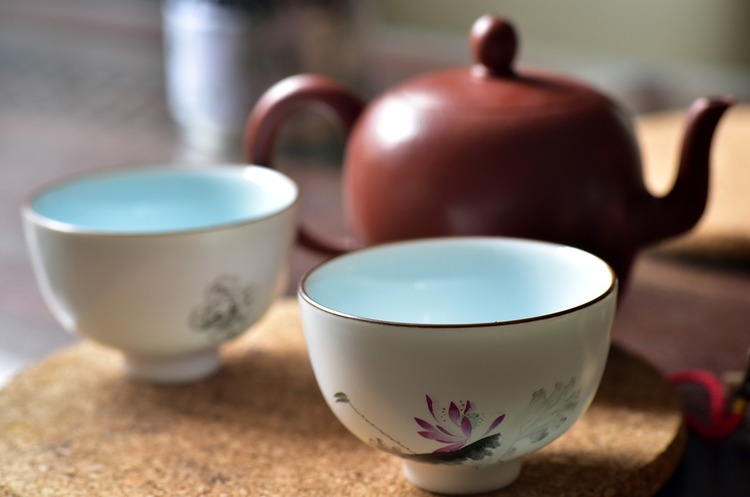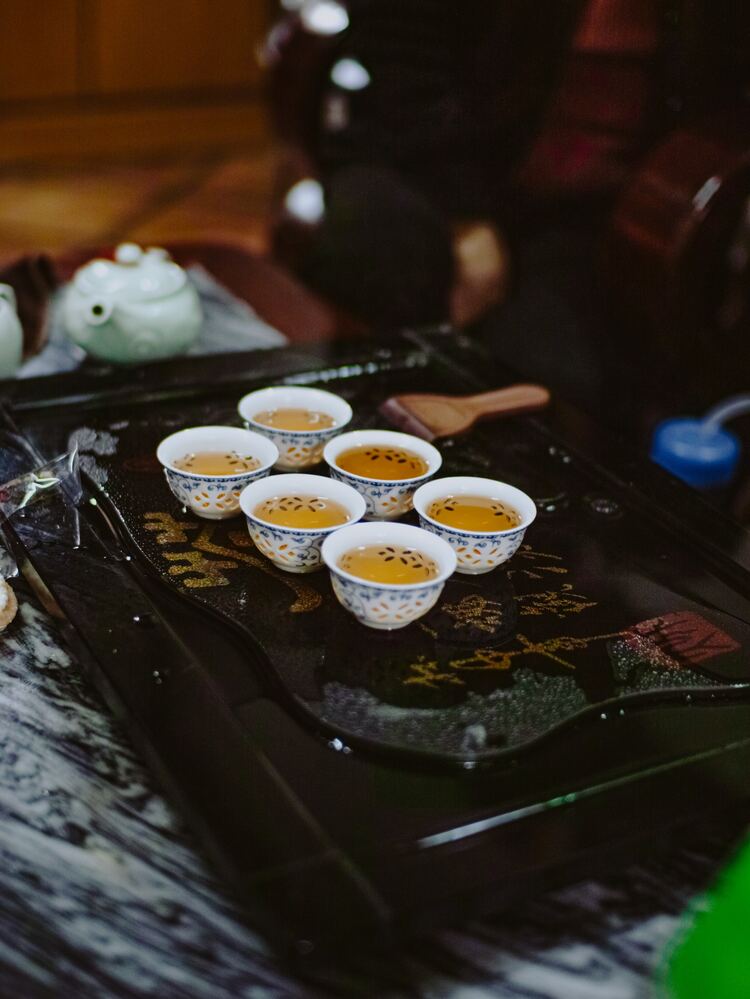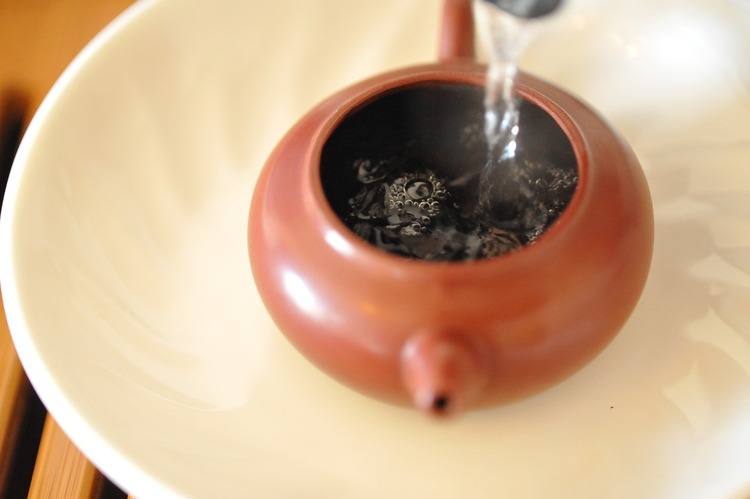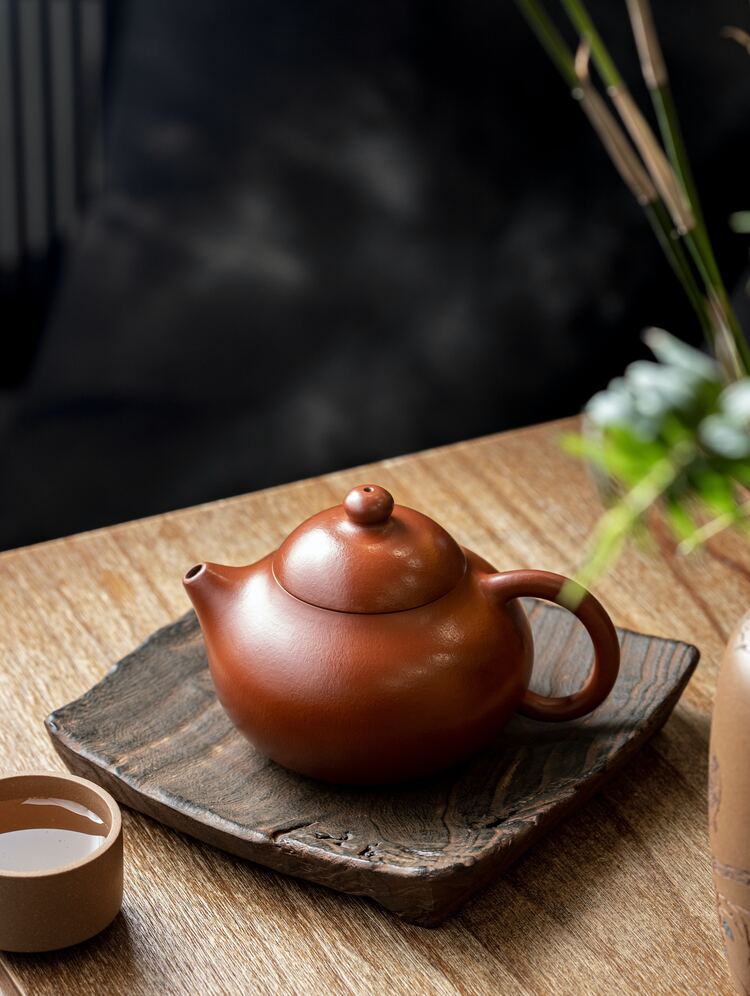I am pretty sure you are familiar with oolong teas, but have you heard of Dancong tea? Dancong, also known as Phoenix tea, is a type of oolong tea grown in the Phoenix Mountain area of Guangdong province in China.
The flavor profile of this tea comes from the specific terroir of this mountain area, as well as the skill of the tea makers in processing the leaves.
Keep reading to learn more about this tea known for its floral and fruity notes, with hints of honey and roasted nuts.
Please note: This article contains affiliate links, meaning I may earn a commission if you make a purchase by clicking a link. Of course, this comes at no extra cost to you and helps me keep offering readers solid information.

History and Tradition
Dancong Tea, also known as Da Cong tea, Phoenix oolong tea, or Feng Huang Dan Cong, has a rich history and tradition that dates back centuries. It originated in the Guangdong province of China, specifically in the Chaozhou region.
The name “Dancong” translates to “single bush,” referring to the traditional method of plucking leaves from individual tea bushes rather than harvesting from multiple bushes. This method is said to produce a more complex and nuanced flavor profile.
Legend has it that Dancong tea was first discovered by a farmer who noticed that a single tea bush produced leaves with a distinct flavor in his garden. He shared the leaves with his neighbors, and soon, the tea became popular throughout the region.
Over time, the tea became known for its exquisite taste, with different varieties named after the specific flavor notes they exhibited.
Today, Dancong remains a beloved part of Chinese tea culture, with many tea enthusiasts seeking out high-quality varieties for their complex and nuanced flavors.
Cultivation and Production
Growing Area
Dancong tea is grown in the Guangdong Province of China, specifically in the Phoenix Mountains and Wu Dong Mountain regions.
The volcanic soil of these mountainous regions provides unique mineral qualities to the tea leaves. The soil composition, altitude, climate, and misty conditions of the region contribute to this tea’s exceptional flavors and aromas.
Tea Plants
Dancong tea is primarily produced from a specific cultivar of the tea plant. A cultivar is a species developed by humans to yield particular characteristics.
This particular tea plant cultivar is known for its slender, elongated leaves, which differ from the broader and larger leaves of Camellia sinensis.
The Dancong tea plant cultivar has a high level of genetic diversity. This diversity results in numerous sub-varieties with distinct characteristics, flavors, and aromas. These sub-varieties are often named after the specific fragrance or taste they exhibit. We will discuss more about these varieties later.
Dancong tea plants are typically propagated through clonal rather than seed propagation. New tea plants are grown from mature and desirable mother plant cuttings. Clonal propagation helps maintain the genetic characteristics and traits of specific sub-varieties.
Some Dancong tea trees are ancient and have been growing for centuries. These ancient tea trees, known as “Gong Chun,” are highly revered and valued for their deep roots and mature flavors. These tea trees’ age and established root systems contribute to the tea’s complexity and depth.
Harvesting Process
Harvesting Dancong tea leaves at the right time is crucial to capture the optimal flavors. The leaves are typically picked during the spring and autumn seasons when they are at their peak.
Skilled tea pickers carefully select individual tea leaves from the tea bushes. They choose the leaves that have reached the desired level of maturity and exhibit the ideal characteristics for producing high-quality tea.
Unlike other tea types, where multiple leaves and a bud are plucked together, Dancong tea is often harvested by plucking a single mature leaf at a time. This selective plucking allows for a more nuanced flavor profile and maintains the integrity of the tea leaves.
The tea leaves are handled carefully to prevent damage and maintain their freshness. Tea pickers use their fingers or small tools to pluck the leaves, ensuring they are not bruised or crushed during harvesting.
Tea bushes are sometimes harvested multiple times throughout the growing season to capture different flavor profiles.
Processing
After the tea leaves are harvested, they undergo meticulous processing to transform into Dancong tea. The leaves are typically withered to reduce their moisture content, rolled to release their flavors, oxidized to the desired level, shaped into long, twisted strips, and baked or roasted to halt oxidation and enhance their flavors.
The specific timing and techniques used during each processing step are carefully determined by experienced tea artisans, aiming to bring out the best of the leaves.

Tasting Notes and Flavors
As mentioned, there are several Dancong varieties. Because of this, you will encounter different flavors when tasting (like the ones mentioned below):
- Honey: The tea has a natural sweetness that is reminiscent of honey. This flavor is most prominent in the aftertaste.
- Ginger: Some teas have a spicy ginger flavor that adds a warming sensation to the mouth.
- Peach: The fruity and floral notes can sometimes reminisce about ripe peaches.
- Gardenia: The aroma of some varieties is often described as floral, with notes of gardenia being particularly prominent.
- Orchids: Another common floral note in Dancong Tea is orchids. This flavor is delicate and can be challenging to detect.
- Honeysuckle: Some teas have a distinct honeysuckle flavor that adds a sweet and floral note to the tea.
- Almonds: The nutty flavor of almonds can sometimes be detected, particularly in the aftertaste.
- Grapefruit: The citrusy notes in Dancong Tea can sometimes be reminiscent of grapefruit.
- Cinnamon: Some teas have a warming cinnamon flavor that adds a spicy note to the tea.
Types of Dancong Tea
Dancong tea encompasses various sub-varieties, each with an associated flavor profile. Here are some popular types:
Mi Lan Xiang (Honey Orchid Fragrance)
Mi Lan Xiang is one of Dan Cong tea’s most well-known and sought-after types. It is characterized by its sweet and floral aroma, which often resembles the scent of honey orchids. The flavor is complex, with notes of honey, ripe fruits, and a pleasant lingering aftertaste.
Xing Ren Xiang (Almond Fragrance)
Xing Ren Xiang is famous for its distinct almond fragrance reminiscent of roasted almonds or marzipan. The tea uniquely combines nuttiness, floral notes, and a sweet aftertaste.
Yu Lan Xiang (Magnolia Flower Fragrance)
Yu Lan Xiang is known for its captivating aroma, resembling magnolia flowers’ fragrance. The tea carries a sweet and floral character with hints of honey, making it a popular choice among tea connoisseurs.
Zhi Lan Xiang (Orchid Fragrance)
Zhi Lan Xiang exhibits a prominent orchid fragrance, hence its name. The tea imparts a floral and slightly fruity taste, often with a smooth and velvety texture.
Huang Zhi Xiang (Yellow Sprig Fragrance)
Huang Zhi Xiang is recognized for its distinct aroma akin to the fragrance of yellow sprigs. The tea offers a rich floral taste, subtle sweetness, and a long-lasting aftertaste.
Gui Hua Xiang (Osmanthus Fragrance)
Gui Hua Xiang is known for its delightful osmanthus fragrance. It produces a tea with a delicate floral aroma and a subtle sweetness reminiscent of osmanthus flowers.
Rou Gui Xiang (Cassia Fragrance)
Rou Gui Xiang is characterized by its unique cassia fragrance, resembling the aroma of Chinese cassia cinnamon. The tea often has a warm and spicy flavor profile with hints of cinnamon and a lingering sweetness.

Preparation Methods
Gong Fu Brewing Method
If you want to enjoy the full flavor of Dancong Tea, then the Gong Fu brewing method is recommended. This method involves using a small teapot (Yixing clay teapot) and brewing the tea in multiple short infusions. This brewing method ensures the best taste. Here’s how you can do it:
- Preheat your teapot and cups by rinsing them with hot water.
- Add the tea leaves to the teapot. The amount of tea leaves will depend on the size of your teapot, but a general guideline is 1-2 teaspoons of leaves for every 6-8 ounces of water.
- Pour hot water over the tea leaves and immediately pour it out. This helps to rinse the tea leaves and awaken their flavor.
- Refill the teapot with hot water and steep it for about 20-30 seconds.
- Pour the tea into your cups and enjoy the fragrant aroma and delicate taste.
- Repeat steps 4 and 5 for multiple infusions, gradually increasing the steeping time with each infusion. You can increase each infusion’s steeping time by 10 to 20 seconds.
Please pay attention to the last step. You can (and should) infuse your oolong tea multiple times. Please make the most out of it!
Gaiwan Brewing Method
You can use a gaiwan to brew tea as well. A gaiwan is a traditional Chinese tea vessel that allows you to control your tea’s temperature and steeping time. Here’s how to use it:
- Warm the gaiwan and tea cups with hot water,
- Add the tea leaves to the gaiwan. Use 1-2 teaspoons of leaves for every 6-8 ounces of water.
- For heavily roasted oolongs, pour hot water over the tea leaves and immediately pour it out. This helps to rinse the tea leaves and awaken their flavor.
- Slowly pour water over the leaves till the rim of the gaiwan.
- Add the lid and steep for 20-30 seconds.
- Pour the tea into teacups. While doing this, hold the gaiwan with your thumb and middle finger. Secure the lid with the index finger.
- Repeat the process with multiple infusions.
Western Style Brewing
If you prefer to brew tea using Western methods, start by heating the water. Put one teaspoon of tea leaves into a tea infuser or strainer and place it in a cup. Pour the hot water over the leaves and let it steep for about 3-4 minutes. Remove the infuser or strainer, and enjoy your tea.
Ideal Water Temperature
The water temperature plays a crucial role in brewing this tea. If the water is too hot, it can burn the delicate tea leaves and ruin the flavor. On the other hand, if the water is too cold, it may not extract the full flavor of the tea leaves. Here’s the ideal water temperature for brewing this particular tea:
- Bring fresh, cold water to a boil.
- Let it cool down for 2-3 minutes until the water temperature reaches around 190-200°F (88-93°C).
- Pour the hot water over the tea leaves and let it steep for the desired time.
Remember to use fresh, cold water that is free of any impurities. Avoid tap water if possible, as it may contain chlorine or other chemicals that can affect the taste of your tea.

Health Benefits and Caffeine Content
This tea offers various health benefits while also providing a moderate amount of caffeine. Here’s what you need to know:
Health Benefits
- Boosts Immune System: Contains antioxidants that help to boost the immune system, reducing the risk of infections and diseases.
- Promotes Weight Loss: Can help to promote weight loss by increasing metabolism and reducing appetite.
- Reduces Stress and Anxiety: Theanine, an amino acid found in the tea, can help to reduce stress and anxiety levels, promoting relaxation and calmness.
- Improves Digestion: Can improve digestion by reducing inflammation in the gut and promoting healthy bacteria growth.
Caffeine Content
Dancong tea contains moderate levels of caffeine. One cup of tea (8 oz) contains approximately 30-40 mg of caffeine, less than a cup of coffee.
You can opt for a decaffeinated tea version if you are sensitive to caffeine.
Buying Guide
When buying this tea, you should remember a few things to ensure you get the best product for your money.
Quality
The quality is determined by the leaves used to make it. Look for tea leaves that are long, twisted, and have a consistent color. Avoid leaves that are broken or have a lot of stems or twigs mixed in.
Label
Make sure you check the label to see where it was grown. Remember, the tea is produced in the Phoenix Mountains in Guangdong Province, China. If the label doesn’t specify where the tea was grown, it may not be authentic.
Tea Leaves
Look for tea leaves picked from older plants, which tend to have a richer, more complex flavor.
To help you choose the best Dancong tea, here are some key features to look for:
| Feature | What to Look For |
| Aroma | Look for tea with a strong, sweet aroma. |
| Flavor | Look for tea with a complex, fruity flavor. |
| Aftertaste | Look for tea with a long, lingering aftertaste. |
| Color | Look for tea with a bright, golden color. |
| Leaves | Look for tea with long, twisted leaves that are consistent in color. |
I recommend visiting a local tea provider or specialist. If, for some reason, you cannot do this, here are some recommendations from an online retailer:

Dan Cong – Wu Dong Oolong Tea Loose Leaf

Premium Mi Lan Honey Orchid Fragrance

Frequently Asked Questions
What is the flavor profile of Dancong tea?
Dancong is known for its floral and fruity aroma and flavor. It has a sweet and refreshing taste with a hint of bitterness. The flavor may vary depending on the variety and processing method.
How is Dancong tea processed?
Dancong tea is processed using a traditional method called “twisting and baking.” The leaves are twisted and shaped into long strips before being baked in an oven to remove moisture and enhance the flavor.
What are the health benefits of drinking Dancong tea?
Dancong tea is rich in antioxidants, which can help boost the immune system and reduce the risk of certain diseases. It also contains caffeine, which can improve mental alertness and concentration.
What are some popular Dancong tea varieties?
Some popular Dancong tea varieties include Honey Orchid, Magnolia, Osmanthus, and Almond. Each type has a unique flavor and aroma.
How should Dancong tea be brewed?
To brew Dancong tea, rinse the leaves with hot water to remove impurities. Then, steep the leaves in hot water for 1-2 minutes, depending on your preference. The water temperature should be around 195°F (90°C).
What is the history of Dancong tea?
Dancong tea has a long history from the Song Dynasty (960-1279). It was initially grown in the Phoenix Mountain area of Guangdong Province in China and was a favorite of the imperial court. Dancong tea is still widely produced and enjoyed throughout China and worldwide.

I hope you enjoyed the article and learned something new. See you next time!
Have you tried this tea?